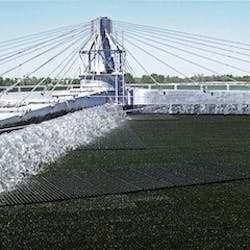Strong Modules to Meet Strict Standards
The City of Stockton, Calif., needed to upgrade its 55-mgd wastewater treatment plant (WWTP) in order to meet National Pollutant Discharge Elimination System (NPDES) regulations for tertiary treatment. The goal of this upgrade was to select a reliable yet economical technology that would achieve tertiary nitrification, especially during the winter months.
After a comprehensive evaluation, nitrifying trickling filters were selected based on low energy consumption, process stability and operational simplicity. Brentwood’s high-density structured-sheet media proved to be a cost-effective solution for achieving optimal nitrification. The chosen media modules yield a 40% higher specific surface area than that of traditional media used in nitrification applications, and they allow for maximum treatment capacity within the smallest footprint.
Additionally, because of the WWTP’s California location, seismic hazards were taken into consideration. The project engineers directed the WWTP to select media based on compression test deflection in order to protect against catastrophic structural failures. Brentwood’s media modules—which are built to a tight deflection standard of 1%—were combined with the AccuPier media support system to meet strength requirements.
In 2006, two nitrifying towers—each with a diameter of 166 ft and a media depth of 22 ft—were constructed. The towers began receiving effluent from oxidation ponds and engineered wetlands, which were designed to decrease solids loading and maintain stable ammonia loading. From there, effluent was discharged to a dissolved air flotation (DAF) tank and tertiary filter for polishing.
The resulting Brentwood trickling filter installation allowed the Stockton WWTP to maintain an ammonia removal rate consistently in excess of 94%, easily meeting the required ammonia discharge permit of 2 mg/L.
